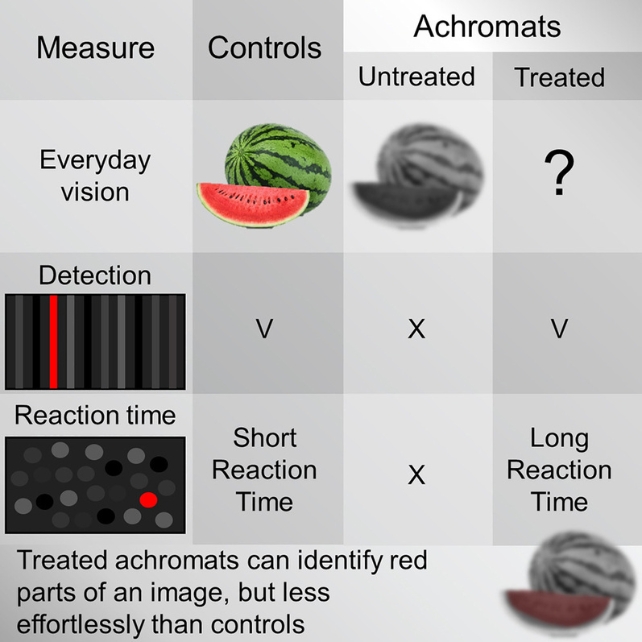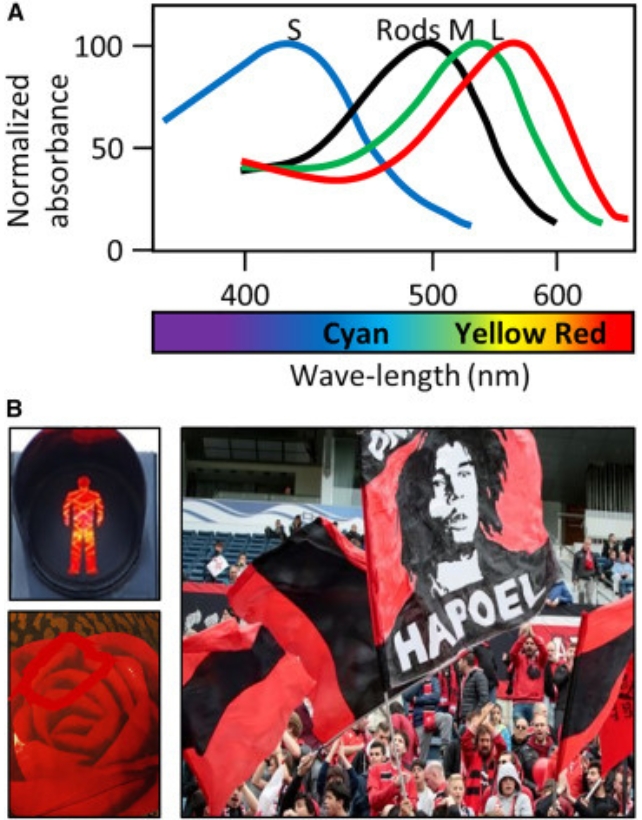A small selection of volunteers who were completely color blind can now faintly detect a splash of color following retinal gene therapy.
Following the trial by researchers in Israel, three adults and one child who could only sense brightness of light found that after gene therapy they were able to tell a red object apart from its darker background.
Achromatopsia is caused by defects in genes that control cone cells, our eyes' color-sensors. The approximately 1 in 30,000 people affected see all the vibrant colors of the world as blurry shades of gray.
A single gene mutation caused the congenital condition in the volunteers, and the researchers hoped that inserting functional copies of the gene into cone cells would allow them to see color.
They found treated 'achromats' can perceive red color, albeit in a very limited way, and differently than normally sighted controls.
"Treated patients with achromatopsia did not open their eyes after the surgery with a feeling of a miracle," neuroscientist Ayelet Mckyton from the Hebrew University of Jerusalem and her colleagues write in their published paper, suggesting the different shades of gray were not replaced by a range of rainbow colors.
"Nevertheless, color detection was evident in all patients' treated eyes."

The researchers used a viral vector to transport a functional copy of the gene into the retina which houses cone cells, in one of each participant's eyes.
The volunteers' vision didn't change dramatically, but tests indicated they could all identify red stripes against dark backgrounds with their treated eye, where previously they saw no color at all.
"When the adult patients were asked to describe how they perceive the red stimulus in the treated eye (when presented in a way that allows them to detect it), they often admitted that they had no appropriate words to describe it," the researchers write.
"Encouraged to find the exact wording, they said it glows differently, shines, or appears on a different plane than the background."
The three types of cone cell in a typical human eye peaks in response to different parts of the electromagnetic spectrum. The activity of the cones, individually and combined, provides our brain's visual system with the information it needs to create the rich rainbow of colors many of us take for granted.

Because bright light stimulates their rod cells, which increase and decrease in response to light intensity and are typically most active at night, people with achromatopsia aren't able to discriminate wavelengths, or colors, leaving them with a monochrome view of the world.
It's possible that the active rod cells interfered with the treated cone cells' ability to produce a signal, preventing the trial participants from seeing in full color.
They may have been able to see red due to rod cells being particularly insensitive to red's longer wavelength. The rod cells could have remained inactive when exposed to red, meaning the cone cells' signals weren't disturbed.
Patients were all tested again a year after the treatment and the results were much the same. To those of us who experience the world in every visible wavelength of color, it may not seem like much, but it's an important step.
Red-green color blindness in adult squirrel monkeys (Saimiri sciureus) was treated with gene therapy in 2009, with similar benefits and drawbacks. After treatment, monkeys were able to see both red and green discs against a gray background, whereas before treatment, only the red disc was visible.
That the monkeys could detect both colors is not the same as proving that they could distinguish colors (like telling red from green), and this study doesn't show that either. Restoring wide-ranging color vision requires the ability to distinguish between wavelengths, according to McKyton and team.
"However, in contrast to the treated dichromatic animals, the ability to detect a wavelength cue out of gray level cues is a completely new skill for the complete colorblind patients," they write, "and therefore a necessary first step toward color vision."
The study has been published in Current Biology.
